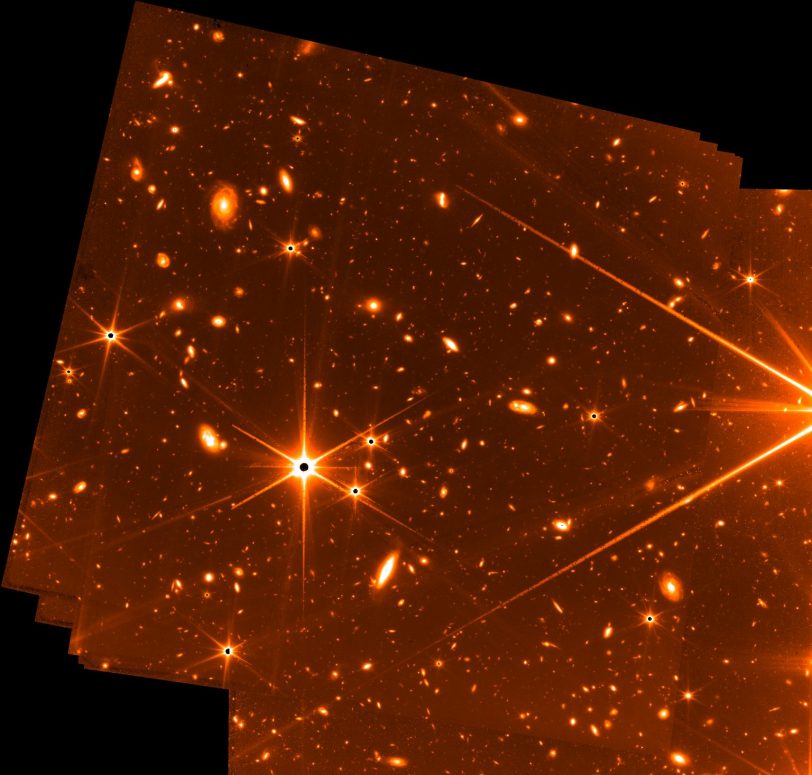The first full-color images from NASA’s James Webb Space Telescope will be released in less than a week, but how does the observatory find and lock onto its targets? Webb’s Fine Guidance Sensor (FGS) was designed with this question in mind by the Canadian Space Agency. It recently captured a view of stars and galaxies that teases what the telescope’s science instruments will reveal in the coming weeks, months, and years.
FGS has always been capable of capturing imagery, but its primary goal is to enable precise science measurements and imaging with pinpoint accuracy. When it does capture imagery, it usually does not keep it: Webb only sends data from up to two science instruments at a time due to the limited communications bandwidth between L2 and Earth. However, during a week-long stability test in May, the team realized that they could keep the captured imagery because there was available data transfer bandwidth.
The resulting engineering test image is a little rough around the edges. It was not designed to be a scientific observation; rather, the data was collected to test how well the telescope could remain locked onto a target, but it does hint at the telescope’s power. It carries some of the characteristics of the viewpoints developed by Webb during its post-launch preparations. Bright stars are distinguished by their six, long, sharply defined diffraction spikes, which are caused by Webb’s six-sided mirror segments. Galaxies cover nearly the entire background beyond the stars.
According to Webb scientists, the result of 72 exposures over 32 hours is one of the deepest images of the universe ever taken. When the FGS aperture is open, it does not use color filters like the other science instruments, which makes studying the age of the galaxies in this image with the rigor required for scientific analysis impossible. Even when capturing unplanned imagery during a test, FGS can produce stunning views of the universe.

“With the Webb telescope achieving better-than-expected image quality, early in commissioning we intentionally defocused the guiders by a small amount to help ensure they met their performance requirements. When this image was taken, I was thrilled to clearly see all the detailed structure in these faint galaxies. Given what we now know is possible with deep broad-band guider images, perhaps such images, taken in parallel with other observations where feasible, could prove scientifically useful in the future,” said Neil Rowlands, program scientist for Webb’s Fine Guidance Sensor, at Honeywell Aerospace.
Because this image was not created with a scientific outcome in mind, there are a few differences between it and the full-resolution images that will be released on July 12. As NASA Administrator Bill Nelson announced on June 29, those images will include the deepest image of the universe ever captured, at least for a short time.
The FGS image is colored using the same reddish color scheme that has been used throughout commissioning on Webb’s other engineering images. Furthermore, no “dithering” occurred during these exposures. Dithering occurs when the telescope repositions itself slightly between exposures. Additionally, the centers of bright stars appear black because they saturate Webb’s detectors, and the telescope’s pointing did not change over the exposures to capture the center from different pixels within the camera’s detectors. The image’s edges and corners also show the overlapping frames of the different exposures.
“The faintest blobs in this image are exactly the types of faint galaxies that Webb will study in its first year of science operations,” Rigby said.
While Webb’s four science instruments will eventually reveal the telescope’s new view of the universe, the Fine Guidance Sensor will be used in every single Webb observation over the mission’s lifetime. FGS has already been instrumental in aligning Webb’s optics. It will now guide each Webb observation to its target and maintain the precision required for Webb to produce breakthrough discoveries about stars, exoplanets, galaxies, and even moving targets within our solar system during the first real science observations in June and once science operations begin in mid-July.
Article Courtesy of NASA JAMES WEBB.
READ MORE: James Webb Space Telescope Might Be Able To Detect Other Civilizations by Their Air Pollution


